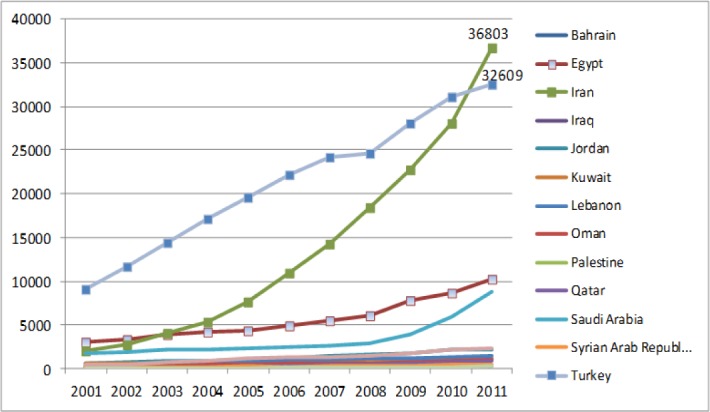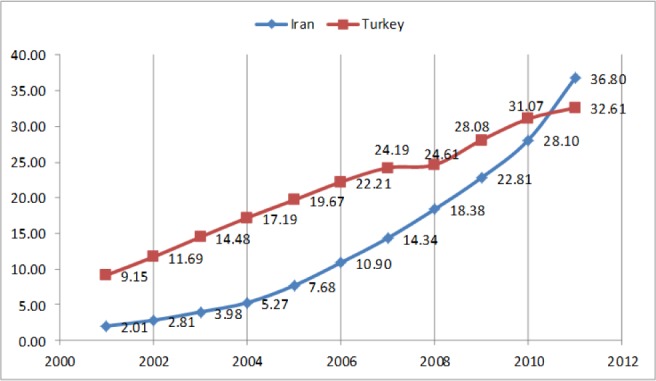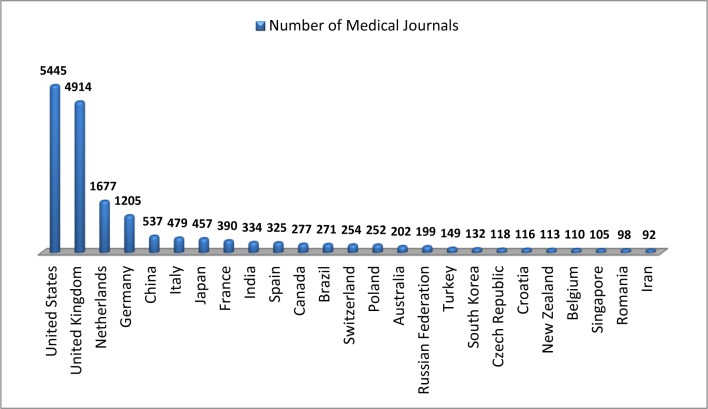Abstract
Background
This study represents scientific production of Iran in medical sciences field at recent years, and the correlation between scientific productions with the number of indexed journals.
Methods
Data extracted from SCOPUS database between years 2000 and 2011, and Iran’s performance measured in terms of different Scientometrics indexes including self-citations, percent of cited articles, number of articles with international collaboration and contribution of Iran in medical sciences in Middle East and world. Moreover correlation between the number of articles, citations, self-citations, and H-index and number of indexed journals for 50 countries in all fields is included.
Results
In 2011 year, Iran contributed 32.77 percent of the Middle East, and accounted for 1.57 percent of the world scientific production. The most frequent document type was original journal article published in English. Retrieved records revealed preferred subject areas, including medicine miscellaneous (14.53 percent of Iran publications in 2011 year). In 2011, according to the number of articles and citations to them, Iran was at 17th and 23th position between 226 countries, respectively. After adjustment for 19708 journals from 50 countries, Iran’s rank based on the number of journals in medical sciences was 24th.
Conclusion
The number of indexed journals with number of articles, citations, self-citations, and H-index of each country showed significant correlation (P-value<0.01). In recent years, by favoring quality over quantity of researches, the new rules have proven to be more effective for discriminating Iranian scientific productions.
Keywords: Medical sciences, Scientometrics, Scientific assessment, Journal indexing, Iran
Introduction
Scientometrics indexes are useful tools for analyzing scientific productions of countries (1, 2). Reviewing references of recent papers in medical sciences indicates that the scientific output of Iran have received expanded attention. However, the assessment of research output for the scientific outputs of Iran, in general, and in particular with emphasize on indexed journals are scarce in literature (3, 4). This may be due to the significant growth in scientific production in recent years, which make up-to-date studies old by the time of their publication. Irrespective of these difficulties, the growth of published articles has increased in domestic and international databases (5). As early as in 2001, there were 2007 articles and 2 indexed journals from Iran, as quoted by SCOPUS (6). In 2011, Iranian researchers published about 36803 articles and indexed 92 journals, and they were active in broad range of disciplines (sub-fields) and sub-disciplines, as reported in this article.
First objective of this paper is to report the results of a scientometrics research regarding the growth of scientific productions of Iran which were indexed in SCOPUS between 2000 and 2011. A second objective of the present work is to analyze the world’s scientific productions, to determine how much the region follows or departs from the worldwide trends. This objective may be fulfilled by analyzing the rank of Iran according to the different Scientometrics indexes including the number of scientific journals covered by SCOPUS databases.
Finally, this study, with international and geographical region interest, tries to show indexing of journals improves visibility, quality and quantity of scientific production.
Materials and Methods
For the period of January 2000 to December 2011, indexed records in all of the science fields in SCOPUS database under any of the 206 countries were retrieved (6). A subset of countries was selected for ranking (according to the number of articles, citations and H-index) and subsequent analysis based on the criterion that they have contributed at least in one percent of total records (7, 8).
Self citations, percent of cited articles, percent of articles with international collaboration and level of Iran contribution in scientific production in Middle East and world were analyzed regarding to retrieved data. We also adjusted 19708 indexed journals in all fields of science in Scopus for 50 countries and ranked countries according to the count of indexed journals (9). In next step we analyzed correlation between the number of indexed journals and number of articles and citations in all fields. Pearson Correlation was used to consider the correlation between number of articles, citations, self-citations and H-index of 50 countries in all fields with the number of indexed journals.
Results
A total of 26,079,465 articles in all fields and 604,495 in medical sciences were retrieved from Scopus database (2011). The scientific production by 10 excellent countries including Iran and Turkey in year 2011 is illustrated in Table 1. According to the citations and H-index, rank of Iran in year 2011 between 226 countries was 23 and 51 (H-index=121) respectively. The portion of Iran in scientific production in world and Middle East was 1.57 and 32.77 percent. Iran’s publication in medical sciences disciplines was 14.53%, and its international rank was 20th. Iran had best rank in reproductive and complementary medicine in comparison to the others 45 medical sciences disciplines (4th in 2011 year). In descending order, United States, China, United Kingdom, Germany, Japan, France, India, Canada, Italy, and Spain had contributed in 6.5%of the total scientific production in survey period. Analysis of 16 Middle East countries yielded 4.44% of their contribution in science production of the world in 2011. Moreover, great disparity in production was observed among the selected countries and Iran (almost 30.9 percent growth per year) and Turkey (almost 4.9 percent growth per year) countries (Fig. 1).
Table 1:
The information of medical sciences outputs of ten excellent countries including Iran and Turkey (SCOPUS, 2011)
| Rank | Country | Documents | Citations | Self-Citations | Citations per Document | H-index |
|---|---|---|---|---|---|---|
| 1 | United States | 519,573 | 625,753 | 353,259 | 1.2 | 1,305 |
| 2 | China | 373,756 | 177,334 | 103,245 | 0.47 | 353 |
| 3 | United Kingdom | 145,899 | 183,651 | 60,479 | 1.26 | 802 |
| 4 | Germany | 137,519 | 169,355 | 60,341 | 1.23 | 704 |
| 5 | Japan | 115,416 | 94,705 | 34,116 | 0.82 | 602 |
| 6 | France | 97,343 | 110,533 | 33,442 | 1.14 | 646 |
| 7 | India | 88,437 | 46,137 | 20,121 | 0.52 | 281 |
| 8 | Canada | 80,679 | 97,201 | 25,652 | 1.2 | 621 |
| 9 | Italy | 77,838 | 86,373 | 26,546 | 1.11 | 550 |
| 10 | Spain | 71,155 | 74,935 | 24,291 | 1.05 | 448 |
| 17 | Iran | 36,803 | 18,476 | 9,426 | 0.5 | 121 |
| 19 | Turkey | 32,609 | 15,450 | 4,843 | 0.47 | 193 |
Fig. 1:

Trend of scientific production of Middle Eastern countries in all fields of sciences, according to the Scopus database
The distribution of scientific production in medical sciences field grouped by geographic regions showed that in Eastern Europe region Russia Federation, in Northern Africa region Tunisia, in Central Africa region Nigeria, in Southern Africa region South Africa, in Northern America region United States, in Latin America region Brazil, in Asiatic Region China, in Pacific Region Australia, and in Western Europe United Kingdom was at the top of the list. As depicted in Fig. 2, for Iran the number of articles with international collaboration is increased exponentially in recent years. In year 2011, 36.80% of Iran’s articles had international collaboration. Concerning the growth observed in scientific production of Iran in the recent years, contribution of Iran to the world production was analyzed with more details for SCOPUS database. First we analyzed the correlation between quality and quantity of Iran’s production by considering the proportion of self citations, percent of cited articles, and number of articles with international collaboration. According to the Pearson Correlation results, the number of articles and citations to articles had positive correlation with number of articles, citations, self-citations, and H-index (Table 2). These results confirm and emphasis the rule of number and quality of indexed journals of countries on the scientific production quality and quantity.
Fig. 2:

Percentage articles with international collaboration from Iran and Turkey according to Scopus database
Table 2:
Correlation between number of articles, citations, self-citations and H-index with the number of indexed journals for 50 countries in all fields
| Number of articles | Number of Citations | Number of Self-Citations |
H index | ||
|---|---|---|---|---|---|
| Number of journals | Pearson Correlation | 0.727** | 0.848** | 0.801** | 0.767** |
| P-value | 0.000 | 0.000 | 0.000 | 0.000 | |
| Number of records | 50 | 50 | 50 | 50 |
We adjusted 19708 indexed journals in SCOPUS (2011) for 50 countries and ranked countries according to the number of journals. According to the results of this analysis Iran was at rank 24th among these countries based on the number of indexed journals in SCOPUS (Fig. 3).
Fig. 3:
Number of journals in subject category of medical sciences field for prime countries in descending order in 2011
Discussion
Our study shows that in the years studied (2000–2011), Iran had a striking growth in quality and quantity of scientific production. Proportionally, the international rank of Iran in all fields improved from 24th in 2007 to 17th in 2011. There are numerous reasons for this exponential growth, but probably one of the most important ones is the improvement of quantity and quaintly of indexed journals. Obviously, research activities and products (i.e., articles) are naturally influenced by available resources, collaboration network, indexed journals, and the feasibility of medical research relies heavily on financial support (10). Growth in Iran’s scientific productivity in recent years is associated with profound improvements in respective research systems and related factors. We are aware that the method we used in this study has several limitations. Despite this, however, this type of studies provides useful information for the evaluation of productivity, and may well constitute a general profile for countries scientific productions (11). First limitation is the criteria for selecting journals and the database utilized for the study. SCOPUS database was chosen as it is the most accessible and utilized scientific database by scientific community and because it was demonstrated to be suitable for scientometrics studies of scientific production. Therefore, with our strategy we did not consider papers which were published in Persian journals or those published in journals when they were not included in SCOPUS (12, 13). However, it must be taken into account that journals with the largest readership are published in English and therefore our Scientometrics analysis was biased toward English language journals (14, 15).
Conclusion
The present study gives a fairly complete and reliable comparative overview of scientific research in Iran between 2000 and 2011.
Ethical considerations
Ethical issues (Including plagiarism, Informed Consent, misconduct, data fabrication and/or falsification, double publication and/or submission, redundancy, etc.) have been completely observed by the authors.
Acknowledgements
The authors declare that there is no conflict of interest.
References
- 1.Schubert A (2002). The Web of Scientometrics-A statistical overview of the first 50 volumes of the journal. Scientometrics, 53:3–20. [Google Scholar]
- 2.Xiaojun Hua RR, Jin Chena (2011). On the definition of forward and backward citation generations. J Informetr, 5:27–36. [Google Scholar]
- 3.Aminpour F, Kabiri P, Boroumand M, Hejazi S (2009). Iranian Medical Universities in SCIE: evaluation of address variation. Scientometrics, 80:253–264. [Google Scholar]
- 4.Aminpour F, Kabiric P (2008). Science production in Iran: the scenario of Iranian medical journals. JRMS, 14:56–61. [PMC free article] [PubMed] [Google Scholar]
- 5.“www.science-metrix.com/30 years in science.”.
- 6.Scopus database. (2011. –2010-1). Available from: http://www.scopus.com.
- 7.Morison L (2008). The Hirsch Index and measuring the quality of scientific papers. Ulster Med J, 77. [Google Scholar]
- 8.Molinari A, Molinarib L (2008). Mathematical aspects of a new criterion for ranking scientific institutions based on the h-index. Scientometrics, 75:339–356. [Google Scholar]
- 9.Van Leeuwen T, Moed H (2001). Development and application of new journal impact measures. Cortex, 37:607–610. [DOI] [PubMed] [Google Scholar]
- 10.Inonu E (2003). The influence of cultural factors on scientific production. Scientometrics, 56:137–146. [Google Scholar]
- 11.Fernández-cano A, Torralbo M, Vallejoa M (2004). Reconsidering Price’s model of scientific growth: An overview. Scientometrics, 61:301–321. [Google Scholar]
- 12.Falagas ME, Kouranos VD, Arencibia-Jorge R, Karageorgopoulos DE (2008). Comparison of SCImago journal rank indicator with journal impact factor. Faseb J, 22:2623–2628. [DOI] [PubMed] [Google Scholar]
- 13.Falagas M (2008). Comparison of PubMed, Scopus, Web of Science, and Google Scholar: strengths and weaknesses. Faseb J, 22:338–342. [DOI] [PubMed] [Google Scholar]
- 14.Yamazaki S, Negishi M (1998). Scientific database for evaluating research performance (English). Joho Kanri, 41:436–444. [Google Scholar]
- 15.Powell R (2006). Evaluation Research: An Overview. Library Trends, 55:102–120. [Google Scholar]



